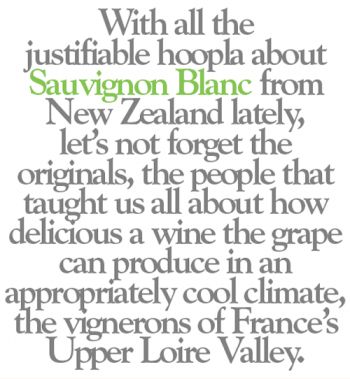Loire’s Sauvignon Blancs
Of
course, the French drive us a bit insane with how
inconsistent their wines remain despite the supposed
guarantees of the AOC system, and Loire Sauvignon is no
exception. But when a Sancerre or Pouilly-Fume hits its
target there is something so clean and penetrating about its
flavors that whatever bother it takes to find the right ones
all seems worth it. Because when one of these wines is right
there is nothing better. Nothing. And the Loire is still a
place where you can find stunning value.
Why do they
remain values, even as the dollar has been in free fall
against the Euro? Because, at least in my opinion, outside
of aficionados the wines are totally overlooked. This is
easy to do since their attraction lies in their elegance and
balance, subtlety and understatement, rather than dramatic
flavor impact. Unlike your typically flamboyant Marlborough
Sauvignon Blanc, the fruit rarely explodes from the glass.
And yet, although the wines have been around seemingly
forever, they are still waiting to be discovered in the US.
The time is ripe. As fashions change and our collective
palate shifts toward greater appreciation for wines with
vibrant acidity to balance the fruit (a transformation
confirmed at numerous public tastings I’ve conducted over
the past few years) Loire Sauvignon Blanc is an obvious
choice.
There’s a
seasonal, perhaps ephemeral element too. Warm weather
generally suggests a lighter diet, more fish and vegetables,
less rich sauces. The Loire is a region where you can find
un-oaked Sauvignon Blanc with the right profile to
complement these dishes and leave your palate refreshed.
Although price may put them out of the range of most
everyone’s picnic wines, they are wonderful choices for
summer dinners on the deck. And there’s a bittersweet
quality to the wines too: although you’d like to see how
they change in the bottle and put some away for a years, the
results are generally disappointing. They’re so good young
they generally have nowhere to go but down after an
appropriate period of perhaps 3 or 4 years after bottling.
So buy enough for current consumption and then buy again
next year.
|
My list of current Domaine J.C. Chateau Domaine Didier |

